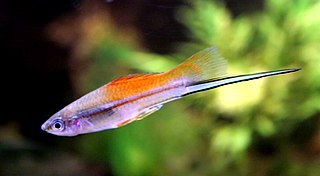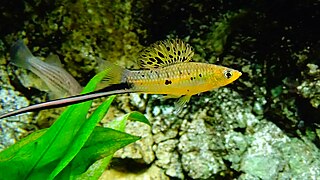
The southern platyfish, common platy, or moonfish is a species of freshwater fish in family Poeciliidae of order Cyprinodontiformes. A live-bearer, it is closely related to the green swordtail and can interbreed with it. It is native to an area of North and Central America stretching from Veracruz, Mexico, to northern Belize.

Xiphophorus is a genus of euryhaline and freshwater fishes in the family Poeciliidae of order Cyprinodontiformes, native to Mexico and northern Central America. The many Xiphophorus species are all known as platyfish and swordtails. Platyfish formerly were classified in another genus, Platypoecilia, which is now obsolete. The type species is X. hellerii, the green swordtail. Like most other new world Poeciliids, platies and swordtails are live-bearers that use internal fertilization and give birth to live young instead of laying eggs like the bulk of the world's fishes. The name Xiphophorus derives from the Greek words ξίφος (dagger) and φόρος (bearer), referring to the gonopodium on the males. All are relatively small fishes, which reach a maximum length of 3.5–16 cm (1.4–6.3 in) depending on the exact species involved.

The sailfin molly is a species of fish of the genus Poecilia. They inhabit fresh, brackish, salt, and coastal waters from North Carolina to Texas and the Yucatán Peninsula of Mexico.

The Monterrey platyfish is a species of freshwater fish in family Poecilidae. A live-bearer, it was native to a very small section of the San Juan River system in the vicinity of the city of Monterrey, Mexico. The specific name refers to the American soldier and naturalist Darius N. Couch (1822–1897) who collected the type on a self financed expedition to Mexico.

The variable platyfish, also known as variatus platy or variegated platy, is a species of freshwater fish in family Poecilidae of order Cyprinodontiformes. A livebearer, it is native to southern Tamaulipas and northern Veracruz states in northeastern Mexico. It is a popular fish in the aquarium trade due to its prolific breeding, as are hybrids with other members of its genus, most notably the southern platyfish.

The marbled swordtail is a species of freshwater fish in the family Poeciliidae. It was endemic to the Rio Salado system in Coahuila, northeastern Mexico. It was restricted to springs, connected creeks and pools in waters with a pH slightly above neutral and temperatures of 16–26 °C (61–79 °F), with captive studies indicating that the optimum temperature is around 24 °C (75 °F).
The Chiapas swordtail or upland swordtail is a species of livebearing freshwater fish of family Poeciliidae, and genus Xiphophorus. It is, therefore, in the same genus as the common platy and the swordtail. The Chiapas swordtail was discovered and first described by Donn E. Rosen in 1960, along with four other species of Xiphophorus.

The green swordtail is a species of freshwater/brackish fish in family Poeciliidae of order Cyprinodontiformes. A live-bearer, it is closely related to the southern platyfish or 'platy' and can crossbreed with it. It is native to an area of North and Central America stretching from Veracruz, Mexico, to northwestern Honduras.

Xiphophorus nigrensis, the Panuco swordtail, is a species of fish in the family Poeciliidae that is endemic to a small part of the Pánuco River basin in Mexico.

Xiphophorus montezumae, the Montezuma swordtail, is a livebearing freshwater fish of the order Cyprinodontiformes, family Poeciliidae, and genus Xiphophorus. It is in the same genus as the common platy and the swordtail. Xiphophorus means 'sword-tail' in Greek.

Xiphophorus nezahualcoyotl, the mountain swordtail, is a live bearing fish in the family Poeciliidae. It is endemic to the northwestern Pánuco River basin in Mexico. The specific name of this fish refers to the poet, philosopher and emperor of Texcoco, Nezahualcoyotl (1402-1472).
Xiphophorus birchmanni, commonly known as the sheepheadswordtail, is a live bearing fish in the family Poeciliidae.

Xiphophorus continens, also known as El Quince swordtail or short-sword platyfish, is a live-bearing freshwater fish in the family Poeciliidae. It is endemic to the Pánuco River basin in east-central Mexico. Its name comes from the Greek conto, meaning short, and Latin ensis, meaning "sword". due to the species' sword size in males.
Xiphophorus malinche, also known as highland swordtail, is a live bearing fish in the family Poeciliidae. It is endemic to the Pánuco River basin in east-central Mexico. This species is named after La Malinche, an Indian slave who played a role in the Spanish conquest as the interpreter, secretary, and mistress of Hernando Cortes.
Limia melanonotata, the blackbanded limia, is a toothcarp in the family Poeciliidae. It is endemic to the island of Hispaniola.
Scolichthys greenwayi is a species of freshwater fish of the family Poeciliidae. It is found in flowing waters along the Rio Chixoy and Rio Salinas system in Alta Verapaz, Guatemala.

Donn Eric Rosen (1929-1986) was a member of the staff of the American Museum of Natural History. He was a Distinguished Fellow of the American Society of Ichthyologists and Herpetologists.

Xiphophorus pygmaeus, the pygmy swordtail, is a poeciliid fish from northeastern Mexico. It is the smallest of the swordtails. The male's sword is barely visible and the species is often called the swordless swordtail. It is sometimes kept in home aquaria, but is a rather delicate species.

Xiphophorus milleri, the Catemaco platyfish, is a poeciliid fish endemic to Mexico's Lake Catemaco and its tributaries. As it has traits of both swordtails and platies, its discovery confirmed that these two groups should be consolidated into a single genus, Xiphophorus.

Astyanax baileyi is a small freshwater fish native to northern Guatemala. Based on several visual aspects, it was once considered a member of the genus Bramocharax, which is now obsolete, and has since been synonymized with Astyanax. As such, former members of Bramocharax are now a part of Astyanax, like Astyanax bransfordii and Astyanax caballeroi.
















